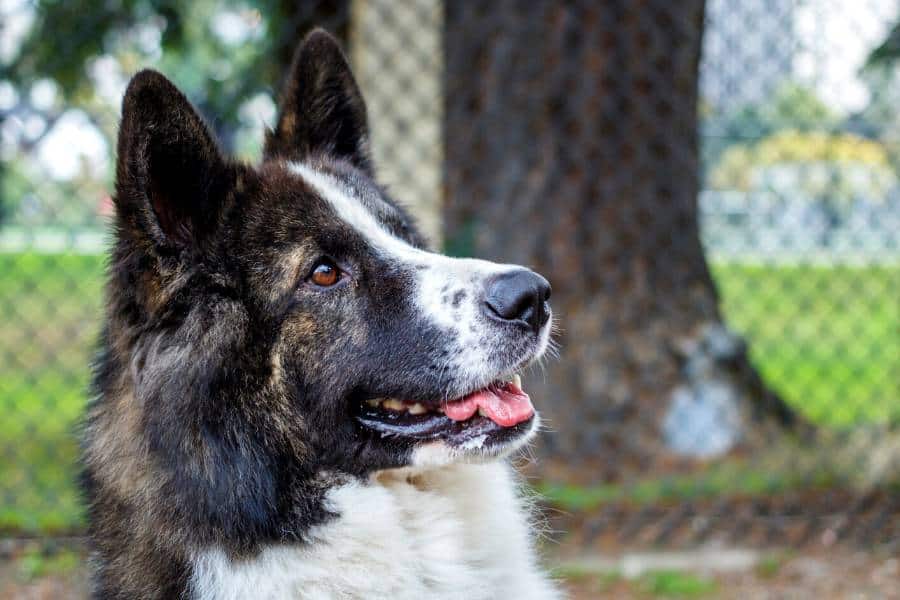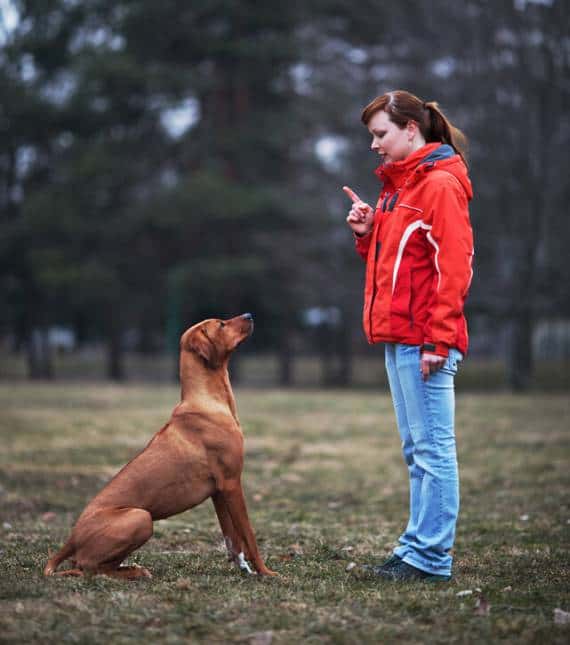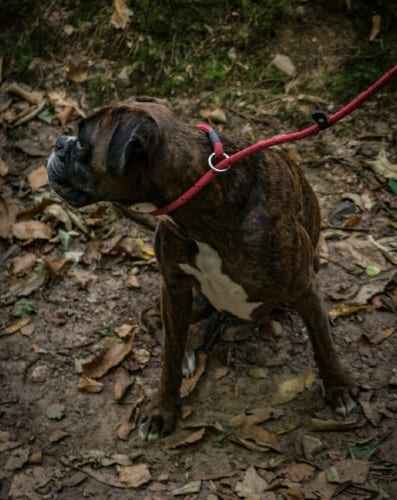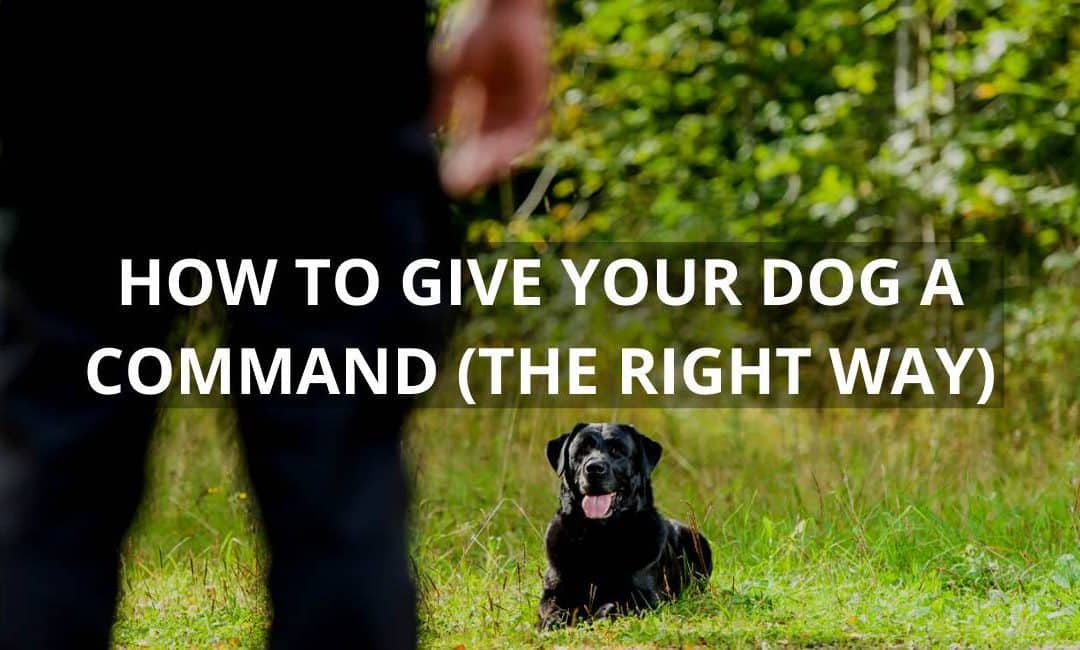Dog owners new to training often marvel at how experienced dog trainers can get their dog to listen to commands. I’ve heard everything from “he really likes you!â€, to “he knows you’re the bossâ€, to “those must be some really great treatsâ€.
The reality is, while I like being likable, I do carry good treats, and I hope I come across as someone worth listening to when working with someone’s dog, getting a dog to listen to commands doesn’t have much to do with any of those things. It’s simpler than that.
How we speak and present ourselves when giving a dog command makes all the difference in how well they listen.
And while a well-trained dog should to listen to commands (almost) regardless of how we say them, there are some straight-forward “best practices†that can help tremendously.
This article covers how to say a command, how to hold yourself as you give it, and basically how to behave so that your dog is more likely to listen to you when you give a command.
Â
How to Give Your Dog a Command: the Short & Sweet Version
First, we’ll start with the short and sweet version of how to give a command. Then we’ll jump into explaining the various parts. (Don’t worry, it’s not complicated. But like anything worth doing, it’s worth doing right. And doing it right will make life with your dog so much easier!)
I’m anticipating that you’ll have questions as you go through this sequence. So be sure to check the FAQ at the end of the article.
Let’s start off by assuming you have your dog present, you have his attention, and your dog understands how to perform the command you’re about to give.
To give your dog a command, stand up straight, and using a clear, normal tone of voice, give a single verbal cue (and/or hand signal, if using) for the behavior you want your dog to do.
As soon as your dog performs the command, reinforce with praise and (optionally) a reward. Release your dog from the command.
That’s it! And yes, it seems pretty simple and straightforward.
Since there are generally at least a few “but, what about?†questions, let’s break it down into parts and give some detail on each.

How to Give Your Dog a Command: Explained and with Tips
Give Your Verbal Cue (“commandâ€) and Hand Signal
The basics: Stand up straight, and give one command (also known as a verbal cue) to your dog in a clear, normal tone of voice.
Tips on voice and body language when giving your dog a command
1. Speak your command / cue in a clear and normal tone of voice. There is no need to play drill sergeant. Avoid teaching your dog that commands will be yelled or barked.
And please! Don’t whine at your dog. Speak the cue as a statement, not a question. Say it as if you expect your dog to respond (even if you don’t).
Your confidence (or lack thereof) absolutely comes through in your voice and affects your dog’s quality of response.
2. As much as possible, maintain relaxed, confident, upright body posture while giving a command.
Holding yourself upright lends authority, and in most cases, helps your dog understand you have the authority to require his attention and obedience.
To a dog, bowing, bending down to the dog, etc. in general will be considered either submissive body language, or an invitation to play.
Neither of which is helpful when asking for compliance to a command.
Avoid going to the other end of the spectrum, however, with stiff, militaristic posture. This can be interpreted as confrontational, or even threatening, and can be as counter-productive as appearing submissive.
Soft dogs may “melt†under too strong a posture, and harder, higher-status individuals may feel pressured to become confrontational in return.
Remember – relaxed, confident, upright.
3. Keep your body language clean and “quiet†when giving commands. The idea with this is to avoid a lot of random moving around, gesturing, bobbing, etc.
The more irrelevant visuals you present to your dog, the harder it is for him to isolate which gestures and body signals he’s actually supposed to be attending to.
So, keep your body still except for any specific gestures or body language that relate to the specific command.
4. You should anticipate giving your command / cue once. That’s not to say you cannot give it again if you don’t get a response, but what you don’t want is to train your dog that the command for lowering his rear to the ground (for instance) is “sit?-sit?-siiitt?-SIT!â€
Praise Your Dog
The basics:Â Once your dog performs the behavior you asked for, you need to let her know she did it right. In other words, praise your dog.
Tips on praising your dog when training
Voice and tone should be sincere (your dog knows if you’re faking) as well as appropriate for the dog, task, and challenge.
This means your praise could be anything from warm and happy (think verbal hug) to authoritative and “schoolmarmishâ€, to clap paws, go wild with glee.
Expression and body language should match your voice (and vice versa). I.e. be natural!
If you’re unsure / not confident about your dog’s response, be sure your lack of confidence doesn’t come through in your voice and/or body language.
Praise should be given AS your dog performs the action. It’s fine to continue with praise after it’s done (assuming the dog is still doing what you asked), but do not wait to praise until after the dog is done.
Continue to praise until you deliver your reward.

As much as possible, maintain relaxed, confident, upright body posture while giving a command. Keep your body language clean and quiet.
Reward Your Dog
The basics: Most times, many times, or sometimes (depending on you, your dog, and where you are in the training process), reward your dog’s correct response.
Tips on how, when, and why to reward your dog
Reward does not imply a particular thing. It can be a treat (anything from a piece of kibble to a highly valued awesome treat), a favorite toy, a fun game, some enjoyable interaction, a privilege your dog enjoys, etc.
Ideally, it’s a good idea to vary the type of reward you use, as well as whether praise is followed by secondary reward.
This variety helps your dog be more resilient and less dependent on a certain reward outcome.
A reward is in addition to praise, not a replacement for it. By following your praise with some kind of tangible reward, you not only speed learning, you increase the value of your praise to your dog.
Conversely, by giving a reward (treat, etc.) instead of praise, you lose the opportunity to build a powerful positive response to verbal praise (which, barring a really bad case of laryngitis, you always have access to).
Release Your Dog
The basics: Now, signal to your dog that he’s no longer “on command†with your release cue.
Tips on using a release word in dog training
Using a release word is a very important step which is often overlooked. It tells your dog when he’s done and can quit what he’s doing.
Not having a clear release leaves the end of the exercise up to your dog, and not you. I’m assuming I don’t have to explain why that’s not the most practical idea!
Please note! A release doesn’t imply that your dog should run off and do his own thing.
To release your dog means that this is the end of the current exercise.
Pick any release word that works for you. Typical release words are okay, release, free, break, all done, that’ll do.
The only caveat is to be sure to pick a word that doesn’t sound too similar to any common command.
I also suggest picking a word that won’t come up typically when you’re working with your dog. (So, if you’re a person who tends to say “okay†a lot in conversation, or when thinking out loud, you might want to pick a different word than “okay†for your release cue.)
Consider having a consistent release routine (that is, specific predictable actions or gestures as you give the verbal release cue).
Personally, I like to open my hands and step off to one side as I say “okay!”. This gesture and simultaneous motion, along with the verbal cue, all work together to help my dog understand he’s free to move about.
Teaching and using a consistent release word is a very important step in dog training. This is what tells your dog he’s done and can quit what he’s doing.
What Not to Do When Giving Your Dog a Command
Don’t use praise as a way of saying “all doneâ€.
Praise should inform your dog that he’s doing it right, not that he’s finished.
What if you need the behavior to go on for awhile, such as with a stay or wait command? Are you not going to be able to tell your dog he’s doing it right, because you’ve taught him that praise means he can quit?
Keep praise and your release cue distinct, so that praise doesn’t become associated with the end of the behavior/exercise.
Avoid getting in the habit of rewarding before or during verbal praise. This mistake will not ruin your training, but will keep it from being as effective as it could be.
When you give two signals at once, your dog will register and respond to the most “salient†signal. For dogs, this means they will barely register verbal praise if they are being given a treat at the same time.
While it’s not the end of the world, it does work against you if you want your dog to understand praise as a solid “awesome, you’re doing great†signal.
For best results, give praise first, wait a heartbeat, then offer your reward.
Don’t give up too quickly. If your dog doesn’t respond immediately, avoid giving up and offering a treat, thinking your dog needs the treat to understand. When you do this, what’s meant to be a reward is transformed into a bribe.
Hands off your dog when giving a command. Because dogs will always pay attention first to tactile signals, touch actually distracts your dog from attending to (i.e. hearing) your verbal command.
So, avoid setting up “interference†when teaching your dog a command. If you taught a behavior by applying physical pressure (such as some methods of teaching sit, by pushing the rear to the ground), you’ll need to wean off the touch aspects before you can get a reliable verbal-only response to the command.
Avoid teaching your dog that commands will be yelled or barked. There’s no need to play drill sargeant when training!
Giving Dog Obedience Commands FAQ
Â
Your dog doesn’t respond when you give a command.
First, ask yourself a few questions to make sure you have good reason to expect your dog to respond.Â
- Have I taught my dog to respond in this particular type of situation? (i.e. Have I put my dog in a situation, or changed the context enough, that he might actually be confused about what I expect?)
- Does my dog understand the command in the way I gave it? (I.e. Did I use the same word, tone, cadence, gesture, etc. That my dog is used to?)
- Did I actually have my dog’s attention when I gave the command?
- Is there some physical reason my dog might not have been able to comfortably perform the behavior? (E.g. hot pavement, fatigue, bodily discomfort/soreness, etc., etc.)
- Is there some emotional reason my dog might not have been able to comfortably perform the behavior? (E.g. is he frightened, over-aroused by activity, intimidated by a nearby dog, etc., etc.)
If there’s a chance you need to go back and address a gap in your training, see my article on troubleshooting why your dog isn’t listening for tips on how to work through the problem. If you think you’re in the clear on the above, see if these help:
Your dog stays engaged – looking at you, attentive – but doesn’t perform the command.
- In this case, try waiting to see if he’ll perform the command. He may be waiting, thinking/processing, expecting you to give him more information. Often, simply waiting will allow the dog time enough to put all the info together and realize something specific is expected of him.
- If he disengages, try again: Say your dog’s name, give the command (once, in the same tone of voice you used before), and then give him a chance to respond. Why? Some dogs learn to wait for you to repeat, insist, etc.
Your dog jumps up, wiggles, mouths, rolls on floor, etc. when given a command.
- Start by ignoring the extraneous behaviors, as much as possible. Stay focused on the behavior you’re asking for. Calmly repeat your cue and wait for a response. The key here is to be calmly persistent, which will (with a little repetition) teach your dog that this is a strategy that just doesn’t pay off.
- This kind of response from your dog can be frustrating (or amusing, depending on your mood and perspective). Be patient. Losing your cool is rarely productive.
-  If no success, put a leash on your dog and use it to prevent any annoying or self-reinforcing behaviors. Start completely over with your command. Don’t try to pick up in the middle. If you need to, walk away from the area and back again with your dog. Then take a deep breath, smile, clearly say your dog’s name and then the command.
Your dog suddenly “gets distracted†and/or wanders off when given a command.
First, make sure your dog wasn’t legitimately distracted. Did your child walk into the room just then? Maybe the neighbor shouted outside?
If there was a legitimate reason for your dog to get distracted, simply start again (and make a mental note that you probably need to work more with listening around distractions).
Some dogs will learn that appearing distracted when a command is given pays off in some way.
Maybe it’s gotten your attention in the past, or possibly you’ve offered a treat in an attempt to regain the dog’s attention.
It could be a stress-related behavior (anxiety of lack of confidence), or it could just be pushiness.
For the dog that gets “opportunistically distractedâ€:
- You can use a verbal interrupter to get dog’s attention, then repeat your cue.
- If your dog’s inclined to walk off and go do his own thing when asked to listen, you can put him on a leash. (Don’t worry, you can graduate to off-leash once your dog understands what the rules and expectations are.)
- You can move away from your dog, which typically will draw the dog toward you, then try again. (Resist the urge to follow your dog around, pleading for his attention. An important part of training is teaching your dog that it’s his job to attend to you.)

Some dogs will learn that getting distracted pays off in some way – with your attention, a treat, or a delay of doing something they don’t want to do.
Your dog responds to your command, but in slow motion.
Slow response to commands can be a result of tension or discomfort, uncertainty or confusion, anxiety, or even pushiness on your dog’s part. For many dogs, simply changing the way you present yourself and give the command will make all the difference.
- Engage your dog in a light, happy way. Encourage your dog to engage with you in a light, happy way.
- Say your dog’s name in a gentle, inquiring voice, then give your command in the same tone.
- Modify your body language and energy so that you’re not adding to your dog’s anxiety, building tension, or creating conflict. Shake out your arms and legs to release tension. Bounce on your toes, take a deep, cleansing breath and SMILE, then try again.
Your dog only listens if you repeat your commands.
If you’re working with a young dog, or a dog new to training in general, or to a particular command, it’s not unusual or unexpected for the dog to need more than one command. Just keep in mind that it should be a stage the dog passes through, and not the end result when your dog is fully trained.
- Make sure you have your dog’s attention when asking for the behavior.
- Give your first cue in a clear, confident tone.
- If your dog used to getting a hand signal along with the verbal cue, try using it. If the lightbulb comes on and he can now do it on the first command, you may just need to spend some more time working on teaching your verbal cue as a separate, distinct signal.
- If the problem is with a particular behavior, make sure your reward and praise are sufficient for the task. Some behaviors are harder than others, so make the payoff worth your dog’s effort. This is especially important when first teaching a cue, and when adding distractions, changing locations, and otherwise taking your dog up levels in his training.
- Try using differential rewards. This requires than you train with a couple different types of food rewards, but can be effective if you can remember to think ahead.
- When your dog requires more than one command to perform the behavior, use an average value reward. This is something your dog likes and considers reinforcing, but isn’t wildly enthusiastic over. Praise should be sincere and warm.
- On those times when he does it on the first command, give an extra-special, super tasty, humdinger of a reward. Praise should be as if your dog just performed a minor miracle.
- With repetition, most dogs will start to see the connection between super high value rewards and responding on the first command.
- You can, of course, use this technique for any kind of desired improvement in response, not just single versus multiple commands.
- Best for last: Always quit on a high note. If you’re working on getting your dog to listen on the first command, and he does it the first time asked, QUIT RIGHT THERE. Don’t fall to the temptation to say, “Oooh! He did it the first time! Let’s see if he’ll do it again!” No. Let that perfect response stand as-is. You can quit the training session, or switch to something else to work on, or take a play break. Whatever you do, allow that perfect response a chance to to settle in the dog’s mind. Why? Because the next time you pick up training that exercise, the last response will be the first thing in his mind. Make sure it’s a good one!
Your dog gets over-excited when praised.
There’s a bit of an art to learning how to work flawlessly with a dog. Part of that art is experimenting, and hopefully finding those “sweet spots†in communicating with your dog.
- If your dog gets wild or unruly with praise, try keeping your voice calm.
- Don’t overdo physical praise like pats and rubbing.
- In fact, with some dogs, it’s best to stick with verbal praise when actually working with the dog. (But this really depends on your dog and you.)
To learn more about this concept, read my post on How Touch Affects Communication in Dog Training.
Your dog thinks “good†mean he’s released.
This is a training issue, in that you’ve taught your dog to do it. How you fix it depends on how strong the behavior is in your dog, and in you.
- If it’s a relatively new behavior, you should be able to train through it. Put some effort into teaching your dog that “good†doesn’t signal the end of the exercise. Try saying “good†quietly, then immediately following with a treat in position, then saying your command again to remind the dog. Repeat several times, then make a show of giving your release word, happily, excitedly, and stepping away.
- If it’s a longstanding behavior, and/or if you don’t think you’ll be able to change, you may want to change what you use to tell your dog that he’s doing things correctly. Try switching your praise word(s) to something he doesn’t associate with being released. Some ideas are: that’s it, nice!, what a boy, excellent, great job, awesome dog, etc.
Wrapping Up
Giving a command so that your dog actually listens to you isn’t magic or trickery. It’s all about how you come across to the dog.
And while each dog is unique (so that you’ll need to experiment to find what feels just right when communicating with him), there are some basic rules that will serve you well in your training routine.
Speaking normally and clearly; holding your body still and upright; and giving your command once (and then allowing your dog a chance to respond) are practical, straight-forward behaviors virtually any dog owner can employ with a little practice.
Follow these tips, and you’ll not only end up with a dog that is far more likely to listen when you give a command, you’ll look like a pro doing it.
I hope you enjoyed this and maybe even learned something new. If you did, please share with your friends!
Best,
julie
(bio)
